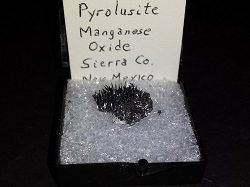A- |
B- |
C- |
D- |
E- |
F- |
G- |
H- |
I- |
J- |
K- |
L- |
M- |
N- |
O- |
P- |
Q- |
R- |
S- |
T- |
U- |
V- |
W- |
X- |
Y- |
Z |
PYROLUCITE:PHYSICAL CHARACTERISTICS:Color is steel gray to a solid black in earthy specimens. Luster is metallic to dull in weather or thinly crusted specimens. Transparency crystals are opaque, translucent in only thin splinters. Crystal System is tetragonal; 4/m 2/m 2/m Crystal Habit is typically massive and compact forms, but also fibrous, acicular, columnar, concretionary, scaly and earthy forms are well known. A thin dendritic habit is commonly seen encrusted on sandstones and siltstones and will form wonderful fern or tree like patterns that are often mistaken for fossil plants. A variety with large, easily visible crystals is called polianite, and occurs as minute prismatic crystals with a square or rectangular cross-section and a wedge-shaped terminations. Cleavage is good in two directions forming prisms, but rarely seen except in rare large crystals. Fracture is conchoidal to uneven. Hardness is 6 in individual crystals, but aggregates can be as soft as 4 or 5 and massive or earthy forms will mark paper and leave powder on fingers (a hardness under 2). Specific Gravity is 4.4 - 5.1 (average for metallic minerals) Streak is black. Associated Minerals are limonite, hematite, quartz, manganite, psilomelane and other manganese and iron oxide minerals. Notable Occurances include nice specimens from Germany; iron mines in Minnesota and Michigan and at Lake County, New Mexico, USA. Pyrolusite is mined in many countries around the world with the most productive countries being Georgia and Ukraine of the former USSR, India, China, South Africa, Brazil, Australia and Gabon. Polianite occurs in abundance at the Kisenge Mine, in Zaire. Best Field Indicators are habits, luster, softness, color and streak.
Pyrolusite is the most common manganese mineral and is an important ore. Manganese is a strategically valuable metal since it is an essential ingredient in steel and other alloys. The mining term "wad" is used to indicate ores that are a mixture of several manganese oxides such as pyrolusite, psilomelane and others that are difficult to distinguish. Pyrolusite is an oxidation product of weathered manganese minerals and also forms from stagnant shallow marine and freshwater bog and swamp deposits. Minerals such as rhodochrosite, rhodonite and hausmannite are often replaced by pyrolusite. Pyrolusite has some interesting habits despite its common occurrence as dull, sooty, black masses and/or earthy forms. Possibly its most popular form is its dendritic habit that forms wonderfully detailed, fern-like patterns on the surfaces of rocks such as sandstone. These dendrites are so amazing that they have often been mistaken for fossil plants. Another popular habit is its acicular or hair-like crystal aggregates that produce nice tufts of "hair", or meadows of shiny black pyrolusite fibers. Often specimens of pyrolusite are very difficult to distinguish from other manganese oxides. Thus, as a consequence of its more abundant distribution, pyrolusite is the default name for black, hair-like manganese crystals or powdery black alteration products of manganese minerals in general.
|

